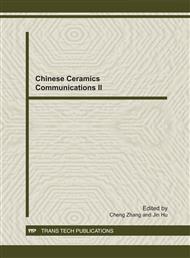p.259
p.263
p.267
p.271
p.275
p.280
p.285
p.290
p.294
Influence of Lanthanum on Microstructure and Dielectric Properties of Barium Titanate Ceramics by Solid State Reaction
Abstract:
La-doped barium titanate ceramics with 0~1.0 at.% La2O3 were prepared by conventional solid state reaction method. The crystal structure and dielectric properties of La-doped barium titanate ceramics were investigated. Lanthanum ions have entered the unit cell and substituted for Ba2+ ions on the A sites of perovskite structure. The a-axis lattice constant increases and the c-axis lattice constant decreases as lanthanum content increases. Addition of lanthanum leads to the fall of the Curie temperature of La-doped BTO ceramics. There are two different doping mechanisms for La-doped BTO ceramics. The dielectric loss of BTO ceramics with 0.3 at.% La2O3 is higher than that of pure BTO ceramics. When lanthanum content is above 0.5 at.%, the dielectric loss of La-doped BTO ceramics decrease with the increasing of lanthanum content. The result of dielectric constant as a function of temperature at different frequencies indicates that La-doped BTO ceramics are not relaxor ferroelectrics but ferroelectrics with diffuse phase transition.
Info:
Periodical:
Pages:
275-279
Citation:
Online since:
November 2011
Authors:
Keywords:
Price:
Сopyright:
© 2012 Trans Tech Publications Ltd. All Rights Reserved
Share:
Citation:


